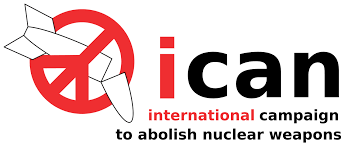| Arms Trade | Drones | Environmental Costs of Militarisation | Extinction Rebellion: Hastings & St L |
|---|---|---|---|
| General Dynamics | Hiroshima Commemoration | TPNW | Trident |

| Arms Trade | Drones | Environmental Costs of Militarisation | Extinction Rebellion: Hastings & St L |
|---|---|---|---|
| General Dynamics | Hiroshima Commemoration | TPNW | Trident |
The Outer Space Treaty | |
 | The Outer Space Treaty of 1967, initiated by the United States, the Soviet Union and the UK, has since been signed by most other nations. It proclaimed space as a "global commons" to be used only for peaceful purposes. It prohibited the siting of weapons of mass destruction in space or on celestial bodies. |
The Nuclear Nonproliferation Treaty (NPT) | |
 |
The Nuclear Nonproliferation Treaty, which came into force in March 1970, is designed to stop the spread of nuclear weapons.
The 190 states parties are split into two categories -
In 1991 South Africa signed the treaty. The South African government confessed that it had secretly built six nuclear weapons, but destroyed them before joining the NPT. In 1992 Belarus, Kazakhstan and Ukraine joined as NNWS nations. All had had nuclear weapons while they were Soviet Republics. The widespread adoption of the Treaty for the Prohibition of Nuclear Weapons should provide an opportunity for reinforcing the NPT. |
The INF Treaty | |
 |
At the height of the Cold War US nuclear weapons were based at Greenham Common and Molesworth, making the UK
a prime target in the event of nuclear war. In 1987, partly in response to peace campaigners, Ronald Reagan, the US President, and Mikhael Gorbachev, the Soviet leader, signed the bilateral Intermediate-Range Nuclear Forces (INF) Treaty. This led to the destruction of 2692 cruise, Pershing and SS20 missiles with a range of 500 to 5500 kilometres 310-3400 miles), and to US nuclear missiles being removed from British soil in 1991. Unfortunately it also permitted the construction of the Trident missile system: submarines at sea equipped with nuclear missiles. |
INF Treaty expired | |
 |
The INF Treaty
expired on 2 August 2019. Neither Donald Trump nor Vladimir Putin was
willing to renew it. This leaves the US and Russia free to resume the production and deployment of intermediate range missiles, threatening a renewed arms race. Missiles launched from the US would not reach Russia, and vice versa; so the US would look to site them in Europe, and probably in the UK. |
The Open Skies Treaty | |
 |
The Open Skies Treaty, signed in 1992, permitted signatories to carry out unarmed reconnaissance flights over
each other's territority, enabling them to keep an eye on military preparations thus allaying mutual suspicions. On 22 November 2020, the United States withdrew from the treaty, and in December 2021 Russia also left, citing the U.S. withdrawal and the inability of member nations to guarantee that information gathered would not be shared with the US. |
The New Strategic Arms Reduction Treaty (New START) | |
 |
New START, which was signed in April 2010
and came into force in 2011, replaced the 1991 START I treaty. The United States and Russia agreed on Feb. 3, 2021, to extend New START by five years, as allowed by the treaty text, until Feb. 5, 2026. It is a bilateral treaty in which Russia and the US agreed to limit the number of nuclear warheads and launchers, including Trident submarines. It does not cover missile defence programmes, previously included in the INF Treaty. |
The Comprehensive Nuclear-Test-Ban-Treaty (CTBT) | |
 |
The Comprehensive
Nuclear-Test-Ban-Treaty would prohibit a nation from permitting or carrying out nuclear
test explosions, whether civilian or military. The treaty was adopted by the General Assembly of the United Nations in September 1996, after years of negotiation. It will not enter into force until 180 days after the 44 states listed in Annex 2 of the Treaty have ratified it. These Annex 2 states are the ones that took part in the CTBT negotiations between 1994 and 1996, and that possessed nuclear reactors in those days. The following have still not signed: India, North Korea and Pakistan. All three have carried out nuclear test explosions since 1996. The following Annex 2 states have signed but not ratified the treaty: China, Egypt, Iran, Israel and the US. However it has been reported that the US may intend to resume nuclear testing. |
The Treaty on the Prohibition of Nuclear Weapons | |
 |
The 2017 Treaty on the Prohibition
of Nuclear Weapons,(TPNW), is the first comprehensive global nuclear weapons ban, initially
supported in 2017 by 122 countries, that is 2/3 of the membership of the UN. It entered into force on 22 January 2021. Under the treaty, states cannot:
|
Nuclear Weapons are now illegal | |
 |
The treaty creates a new international standard for nuclear weapons: they are now illegal under
international law. Previous weapons prohibition treaties include -
|
The Background to TPNW | |
 |
The battle over the introduction of the TPNW raged in the UN for over three years. Accident, miscalculation or
design faults were seen as the main threats to be addressed. All 9 nuclear powers boycotted the process and the US
led the effort to block TPNW by sending out letters to all signatories to withdraw. Russia, US, UK and France
remained united against it, but in contrast China tweeted, “we have always been advocating complete prohibition
and we make a continuous efforts towards a nuclear weapon free world”. The truth is that everyone - yes, including Trump and Putin - would feel safer in a nuclear-free world; we would all be better off in every way. There will be no winner in a nuclear conflict. The TPNW is one step away from that brink. |
Opposition to TPNW. | |
 |
False claims that TPNW is a threat to the Nuclear Non-Proliferation Treaty (NPT) abound,
whereas actually they
are completely compatible. However President Obama sent out an order to many countries to desist from supporting
the treaty; five of those countries, Belgium, Germany, Italy, Holland and Turkey host nuclear weapons. Japan and South Korea also boycotted the Treaty as naive and dangerous, asserting that it could increase the risk of nuclear use. Meanwhile Antonio Guterres (Secretary General of UN) has said of the treaty, “It is clear that we will be only be safe on the day that nuclear weapons no longer exist.” |
Public Opinion | |
 |
The people's view is often very different from their governments'; for example surveys show that over
70% of
Australians, Norwegians, Swedes, Japanese, Finns and Italians and 65% of Americans are now in favour
of TPNW. Many supporting programmes such as "Don't bank on the Bomb", are becoming ever more significant and for instance 400 cities in the world, including Hastings, have endorsed TPNW, indicating a groundswell of popular opinion in favour of its adoption. Global financial institutions, bound by international law and keen to establish themselves as responsible investors, will be increasingly hesitant about investing in these 'controversial' weapons now they have been delegitimised by the majority of nations. Countries signatory to the treaty will be obliged to refuse any sort of assistance to nuclear-armed states in respect of these weapons. |
Now is the time | |
 |
TPNW challenges the entire logic of deterrence. At the present time we are in a state of extreme peril with
the 1947 Doomsday Clock set at 100 seconds to midnight. This is the most dangerous period since the Cuban
crisis of 1962 and tensions between the US and China and US and Russia are the worst in decades. However in the first few weeks of 2021, since the change of the presidency in the USA, there has been a new and significant development in bilateral and multilateral nuclear policy. On 26 January, only 4 days after the TPNW came into force, the United States and the Russian Federation agreed to extend the bilateral cap on U.S. and Russian nuclear arsenals, the New Strategic Arms Reduction Treaty ("New START") for five additional years. |
Nuclear Alliances | |
 |
Non-nuclear states which are signatories of the Nuclear Nonproliferation Treaty already have an obligation not to acquire nuclear weapons but the
new Treaty also adds that states are not to seek, induce or assist anyone to engage in prohibited activity
possession and further use of nuclear arms. This already rules out nuclear arrangements in existing alliances such as NATO and the Asian nuclear alliance of Japan, South Korea and Australia. So far, countries in such alliances have not joined the TPNW, because if there was for example a major power confrontation in Asia, the TPNW would prohibit a state from calling upon a nuclear power to threaten action on their behalf; this would effectively neutralise their nuclear alliance. |
Human Centred Security | |
 |
With the introduction of TPNW we see a paradigm shift, away from the security of states
and towards human centred security and to an affirmation of international humanitarian and
human rights law, and this change is out there for the whole world to see. That is possibly
the most important thing about it. The International Red Cross has stated that nuclear weapons are both morally unacceptable and unreconcilable with international humanitarian law. In 2018 the UN Human Rights Commission stated that nuclear weapons are incompatible with the Right to Life of every human being. TPNW counters the current framework of exclusive interaction at the state level towards individual human rights. TPNW is a threat to the theory of deterrence because the nuclear threat is illegal. Nukes are not an acceptable basis for security. This idea reinforces the obligation for nuclear disarmament which is cited in the TPNW preamble and provides a path to a world of free of nuclear weapons. Non-nuclear-weapon states have been calling for decades for nuclear disarmament in the United Nations forum and via the Nuclear Nonproliferation Treaty but have seen that nuclear-armed states have not moved in any decisive way to a nuclear free world, in spite of their clear obligations under the NPT. They have therefore decided, with TPNW, to create a new path towards getting nuclear disarmament moving again in conjunction with the NPT. The TPNW marks the beginning of the end of the military hegemony of the nuclear-armed powers as nation after nation asserts its right to live in a world free of the threat of nuclear annihilation by deliberate act or, far more likely, a miscalculation. In time the nuclear powers may be seen as dangerous outdated anomalies. But our work is not done. We must keep campaigning to make sure the treaty lives up to its full potential. Once it has taken full legal effect, countries that have joined it will need to comply with all of its obligations. In countries like the UK that have not joined, it is up to us to make sure that companies, governments and people know that nuclear weapons are illegal and that they need to stand on the right side of history. Chatham House, right at the heart of NATO thinking, has published proposals for moderating NATO opposition to the TPNW, avoiding outright opposition. Note however that the General Assembly of the United Nations does not have powers to enforce this Treaty. This power lies with the UN Security Council, each of whose Permanent Members has a veto. None of the nuclear powers, including the UK, has agreed to support the Treaty. |
The Next Meeting of Ratifying States | |
 | The next meeting of states which have ratified the Treaty takes place in March 2025. The UK has not agreed to attend even as an observer. |
Now it's up to us | |
 |
We must
|